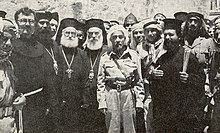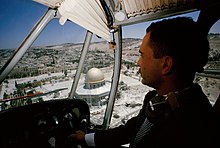Pelayan Bait Kudus Yerusalem
Halaman ini sedang dipersiapkan dan dikembangkan sehingga mungkin terjadi perubahan besar. Anda dapat membantu dalam penyuntingan halaman ini. Halaman ini terakhir disunting oleh 미솔파 (Kontrib • Log) 2155 hari 165 menit lalu. Jika Anda melihat halaman ini tidak disunting dalam beberapa hari, mohon hapus templat ini. |
Hashemite custodianship of Jerusalem holy sites refers to Jordan's royal family role in tending Muslim and Christian holy sites in the city of Jerusalem.[1] The legacy traces back to 1924 when the Supreme Muslim Council, the highest Muslim body in charge of Muslim community affairs in Mandatory Palestine, accepted Hussein bin Ali (Sharif of Mecca) as custodian of Al-Aqsa. The custodianship became a Hashemite legacy administered by consecutive Jordanian kings.




Jordan controlled East Jerusalem and the West Bank in 1948, and annexed the territories in 1951 until they were lost to Israel during the 1967 Six-Day War. Jordan renounced claims to the territory in 1988, and signed a peace treaty with Israel in 1994, whose 9th article states that Israel commits to "respect the present special role of the Hashemite Kingdom of Jordan in Muslim Holy shrines in Jerusalem" and that "when negotiations on the permanent status will take place, Israel will give high priority to the Jordanian historic role in these shrines." In 2013, an agreement between Jordan and the Palestinian Authority recognized Jordan's role.
Al-Aqsa and the Dome of the Rock were renovated four times by the Hashemite dynasty during the 20th century. In 2016, King Abdullah II participated in funding renovation of Christ's tomb in the Church of the Holy Sepulchre, and in 2017, Abdullah donated $1.4 million to the Jerusalem Islamic Waqf, the Jordanian authority responsible for administering Al-Aqsa. An independent report estimates the total amount that the Hashemites have spent since 1924 on administering and renovating Al Aqsa as over $1 billion.[2]
Intermittent violence at the Temple Mount between the Israel Defense Forces and Palestinians evolves into diplomatic disputes between Israel and Jordan.
History
Among Sunni Muslims, the Temple Mount is widely considered the third holiest site in Islam. Revered as the location where Muhammad ascended to heaven, the site, known as the "Noble Sanctuary", is also associated with Jewish prophets who are venerated in Muslim religion. The Al-Aqsa Mosque and Dome of the Rock were constructed on the mount by Umayyad Caliphs. In 692 AD, the dome was constructed, making it one of the oldest Islamic shrines to exist.[3]
The legacy traces back to 1924 when the Supreme Muslim Council, the highest Muslim body in charge of Muslim community affairs in Mandatory Palestine, accepted Hussein bin Ali (Hashemite Sharif of Mecca) as custodian of Al-Aqsa. The Hashemites are descendants of Muhammad, who ruled over the holy city of Mecca for 700 years until they were ousted by the House of Saud in 1924. The custodianship became a Hashemite legacy administered by consecutive Jordanian kings. Sharif Hussein was buried in 1931 near the Al-Aqsa mosque where his funeral also took place.[4]
The sharif's son, Abdullah I (the first King of Jordan) is said to have personally extinguished a fire which engulfed the Church of the Holy Sepulchre in 1949.[5] Jordan under Abdullah I had occupied East Jerusalem and the West Bank during the 1948 Arab–Israeli War and annexed the territories in 1951. Abdullah I was assassinated a year later as he was entering the mosque to pray.[6] King Hussein in 1965 ordered the construction of a palace in East Jerusalem in 1965 to symbolize Jordan's sovereignty. It was abandoned after Jordan lost control of the West Bank to Israel during the 1967 Six-Day War, and the palace remains uncompleted to this day.[7]
Jordan renounced claims to the territory in 1988, and signed a peace treaty with Israel in 1994, whose 9th article states that Israel commits to "respect the present special role of the Hashemite Kingdom of Jordan in Muslim Holy shrines in Jerusalem" and that "when negotiations on the permanent status will take place, Israel will give high priority to the Jordanian historic role in these shrines". In 2013 an agreement was signed between the Palestinian Authority (represented by Mahmoud Abbas) and King Abdullah II recognizing Jordan's role, replacing the decades-old verbal agreement.[8]
Jordan recalled its ambassador to Israel in 2014 following tensions at Al-Aqsa Mosque between Israelis and Palestinians. Abdullah met Israeli prime minister Benjamin Netanyahu in Amman in late 2014, and the Jordanian ambassador returned when Israeli authorities eased restrictions and allowed men of all ages to pray at Al-Aqsa for the first time in months.[9]
In 2016, King Abdullah II participated in funding renovation of Christ's tomb in the Church of the Holy Sepulchre, and in 2017, Abdullah donated $1.4 million to the Jerusalem Islamic Waqf, the Jordanian authority responsible for administering Al-Aqsa. An independent report estimates the total amount that the Hashemites have spent since 1924 on administering and renovating Al Aqsa as over $1 billion.[2] The Greek Orthodox Patriarch of Jerusalem commenting on the King's donation to the renovation of the Church: "Jordan’s role in protecting Christian existence in the Holy Land is clear and undeniable, King Abdullah spearheads the efforts of all Jordanians to sow the seeds of love and brotherhood between Muslims and Christians. We are reaping the fruits of these efforts in this age when sectarian wars are burning entire countries as can plainly be seen."[10]
On 24 July, following the 2017 Temple Mount crisis, Israel agreed to remove metal detectors from Al-Aqsa after Abdullah phoned Netanyahu. However, it is unclear if Jordan influenced Israel's decision.[11]
Leaders of the Church of the Holy Sepulchre issued a statement of support to Abdullah on 1 March 2018 after Israel shelved a proposed bill that aimed to propose new tax measures to churches in the West Bank. "Your defence of religious freedom and Your leadership, in ensuring that the Status Quo is respected and maintained, has been crucial in our ongoing attempts to guard and protect the Christian presence especially in the Holy City of Jerusalem", the statement read.[12]
Recognition
Israel, the Palestinian Authority, the Arab League, United States, European Union and Turkey recognize Jordan's role.[13][14]
In December 2017, Federica Mogherini, the European Union foreign policy chief said that "Jordan has a very special role, when it comes to the holy places, His Majesty, the King of Jordan [Abdullah II], is the custodian of the holy places and he is a very wise man."[15]
References
- ^ "Jordan's Christians throw weight behind King's pro-Jerusalem push". The Jordan Times. 19 December 2017. Diakses tanggal 18 January 2018.
- ^ a b "Amid Temple Mount tumult, the who, what and why of its Waqf rulers". Dov Lieber. The Times of Israel. 20 July 2017. Diakses tanggal 14 January 2018.
- ^ Rizwi Faizer (1998). "The Shape of the Holy: Early Islamic Jerusalem". Rizwi's Bibliography for Medieval Islam. Diarsipkan dari versi asli tanggal 2002-02-10.
- ^ "Kingdom remembers Sharif Hussein Bin Ali". The Jordan Times. 3 June 2017. Diakses tanggal 16 June 2018.
- ^ Cohen, Raymond (2008). Saving the Holy Sepulchre: How Rival Christians Came Together to Rescue Their Holiest Shrine. Oxford University Press. hlm. 84. Diakses tanggal 16 January 2018.
- ^ "Assassination of King Abdullah". The Guardian. 21 July 1952. Diakses tanggal 16 June 2018.
- ^ "How Six-Day War Left Hashemite House's Dreams of Jerusalem Palace in Ruins". Haaretz. 17 May 2017. Diakses tanggal 22 June 2018.
- ^ "Jerusalem deal boosts Jordan in Holy City: analysts". AFP. The Daily Star. 2 April 2013. Diakses tanggal 22 February 2017.
- ^ Hattar, Mussa (16 November 2014). "Fearing backlash, Jordan asserts Al-Aqsa custodianship". The Times of Israel. Diakses tanggal 18 February 2017.
- ^ "King Abdullah II of Jordan funds Holy Sepulchre restoration work". Vacitan Insider. 11 April 2016. Diakses tanggal 20 January 2018.
- ^ "Israel Agrees to Remove Metal Detectors at Entrances to Aqsa Mosque Compound". The New York Times. 24 July 2017. Diakses tanggal 4 September 2017.
- ^ "Jerusalem Church leaders thank Jordan's King Abdullah for support during Israel tax protest". The National. 1 March 2018. Diakses tanggal 5 March 2018.
- ^ "Arab League values Jordan's pro-Jerusalem efforts". The Jordan Times. 27 July 2017. Diakses tanggal 4 September 2017.
- ^ "Erdogan reaffirms Jordan's protection of Jerusalem's Islamic Awqaf". The Jordan Times. 10 May 2017. Diakses tanggal 4 September 2017.
- ^ "We should listen to the wisdom of King Abdullah — Mogherini". The Jordan Times. 8 December 2017. Diakses tanggal 28 December 2017.
Templat:Islamic structures on the Temple Mount Templat:Temple Mount Templat:Old City (Jerusalem)